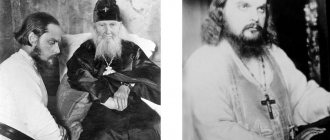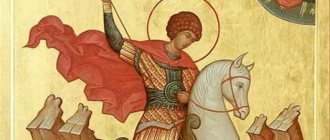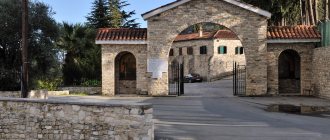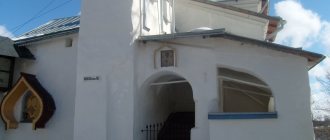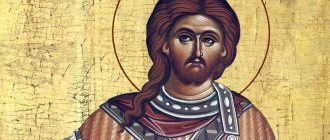Church honors the memory of St. Sergius, the Wonderworker of Radonezh , on October 8 (September 25, old style), the day of his repose. The Monk Sergius of Radonezh is rightfully one of the most revered monks from the times of Ancient Russia to the present day. He is the founder of several monasteries, among which the Trinity-Sergius Lavra became the most famous. It is no coincidence that Sergius of Radonezh is often called “abbot of the Russian land.”
The exploits of St. Sergius occurred in a difficult era, when Russia was under the yoke of the foreign Mongol-Tatar yoke, but strived to gain independence and build a strong and united state. Sergius of Radonezh , a man of desert life who never took up arms, became a spiritual support in the resistance to the Mongol-Tatar yoke, inspired princes and warriors to fight for the independence of Russia. He blessed the Moscow prince Dimitry Donskoy for the Battle of Kulikovo , which took place in 1380. Also, the Radonezh abbot sent two monks, who had once been warriors, to help the prince - Peresvet and Oslyabya. Thus, it became a symbol of the unity of the Church and the people at a time of difficult trial. The victory of rising Moscow over Mamai on the Kulikovo Field significantly strengthened the young principality.
Youth of Bartholomew
The famous church writer of ancient Russia, Epiphanius the Wise (d. c. 1420), who became the de facto hagiographer of St. Sergius of Radonezh, reports that the future ascetic of the Russian land was born near the city of Rostov in the village of Varnitsa. The saint's father was the local boyar Kiril , who served with the Rostov appanage princes, and his mother was his wife Marya .
Prayer of St. Epiphanius the Wise before starting work on the Life of St. Sergius. Miniature of the Front Life of St. Sergius. Moscow. End of the 16th century Moscow, RSL
According to the text of Epiphanius, the date of birth of Bartholomew (as it was named at the baptism of Sergius) is May 1322, however, in the second quarter of the 15th century, the Life of Sergius of Radonezh was revised by the hagiographer, editor of a number of Lives, Pachomius Logothet (d. not earlier than 1484), according to the text of which the date of birth of Bartholomew - May 3 (O.S.) 1314. The Life of St. Sergius tells that during the Divine Liturgy, even before the birth of her son, his mother and the worshipers heard the baby exclamation three times: before the reading of the Gospel, during the Cherubic Song, and at the moment the priest said “Holy of Holies.” From the first days of his life, Bartholomew did not take his mother's milk on Wednesdays and Fridays. At the age of seven, the boy was sent to learn to read and write with his brothers, the elder Stefan and the younger Peter. It so happened that at first learning was not easy for Bartholomew, unlike his older brothers, who learned the alphabet and acquired the skill of reading in a matter of months. The teacher scolded him, his parents were upset. The youth Bartholomew, meanwhile, prayed to God with tears, asking for help. But his studies were still not easy for him. And then an event occurred, which is reported in all the biographies of Sergius.
One day his father asked him to keep an eye on a herd of princely horses. At some point, several horses separated from the rest of the group and entered the forest. Bartholomew immediately went in search of them. In a forest tract, he came to a hillock on which an amazingly beautiful oak tree grew. The boy suddenly saw a handsome old man under a tree, praying. After the elder finished praying, Bartholomew told him that he wanted to learn to read and write, but he was not succeeding, and asked the elder to pray to God. Having completed the prayer, the hermit took the reliquary out of his knapsack and took a piece of prosphora from it and, crossing it, ordered it to be eaten with the words:
This is given to you as a sign of God’s grace and understanding of the Holy Scripture <...> about literacy, child, do not grieve: know that from now on the Lord will grant you good knowledge of literacy, greater than that of your brothers and peers.
The elder was about to leave, but Bartholomew asked him to visit his parents' house. The parents greeted the guest with honor and set the table for him. But the elder said that first one must taste spiritual food, and ordered Bartholomew to read the Psalter. The boy began to read, pronouncing the psalms easily and clearly, which surprised his parents. When leaving, the elder said to Bartholomew’s parents:
Your son will be great before God and people. It will become the chosen abode of the Holy Spirit.
Since childhood, he preferred silence and spent time praying
Cyril and Maria had 4 children; at birth, Sergius received the name Bartholomew. There are many legends about his childhood. The life describes a case when Mary, pregnant with Bartholomew, came to church, and he cried out three times in the womb. The boy did not breastfeed on Wednesdays and Fridays, and also when his mother ate meat.
When Bartholomew grew up a little, he was not eager to participate in games and pampering. He observed strict fasting, which often resulted in disagreements with his mother. The boy loved silence and even then spent a lot of time in prayer. When Bartholomew turned 12, he asked his parents for a blessing to become a monk. True, they did not give consent; they asked to wait for their death.
Monk Sergius - founder of the Holy Trinity Monastery
Around 1328, Bartholomew's greatly impoverished family moved to another permanent place of residence - to the city of Radonezh. Epiphanius writes how Bartholomew’s father became impoverished: “Let’s also talk about how and why he became impoverished: because of frequent trips with the prince to the Horde, because of frequent Tatar raids on Rus', because of frequent Tatar embassies, because many heavy tributes and fees from the Horde, due to the frequent lack of bread.” Bartholomew's elder brother got married a few years later, and his aging parents decided to go to the Khotkovo-Pokrovsky Monastery (1308), accept monasticism there and live until their death. After the repose of their father and mother, Bartholomew and his brother Stefan went to the Khotkovo-Pokrovsky Monastery to become monks.
Ensemble of the Khotkovo-Pokrovsky Monastery. Contemporary photography
However, Bartholomew did not like life in a communal monastery. He strove for solitary asceticism, for living in the desert. He did not live long in this monastery. Having convinced Stefan to become hermits, he and he founded a hermitage on the banks of the Konchura River, on Makovets Hill, in the middle of the dense Radonezh forest. There they erected a small wooden church in the name of the Holy Trinity (consecrated in 1340), on the site of which the cathedral church of the Trinity-Sergius Lavra , which can still be seen today.
Trinity Cathedral of the Trinity-Sergius Lavra. Contemporary photography
Stefan, having experienced all the difficulties of desert life and its needs, left his brother and settled in the Epiphany Monastery in Moscow, where he met the monk Alexy (between 1292-1305 - 1378), the future Metropolitan of Moscow and All Rus'. Bartholomew, calling on Abbot Mitrofan, received monastic tonsure from him with the name Sergius. This happened on the day of the celebration of the memory of the martyrs Sergius and Bacchus.
Rumors about the exploits of the young hermit began to spread throughout Rus'. A few years later, new cells began to appear in the vicinity of the Sergius monastery. Gradually, a monastery was formed from the disciples of Sergius, which in 1345 took shape as the Trinity-Sergius Monastery (later the Trinity-Sergius Lavra). Sergius was its second abbot (the first was Abbot Mitrofan). Sergius introduced new rules for the life of the monks of his monastery. Having forbidden accepting alms, he decreed in the monastery charter that all monks should eat from their labors. He himself set an example in his daily work. Little by little the glory of the Sergius Monastery increased. Those wishing to live a monastic life came to the monastery from various classes of ancient Rus', from common peasants to princes. Some settled next to the monastery and donated their property to the needs of the holy monastery.
Over the years, the desert, which suffered extreme need for everything necessary, turned into one of the most beautiful monasteries in Rus'. The fame of the founder of the monastery even reached the walls of Constantinople. The Ecumenical Patriarch Philotheus (c. 1300-1379) sent a delegation of Greek monks to Sergius, who presented him with a cross, a paraman, a schema and a letter praising him for his virtuous life. The Patriarch also sent an exemplary monastic Charter of cinnovia (strict communal living). Having studied the Greek charter, with the blessing of the Moscow Saint Alexy, Sergius introduced communal living orders in the monastery, which later took root in other Russian monasteries. It is interesting that Metropolitan Alexy of Moscow and All Rus', shortly before his death, turned to Sergius with a request to become a candidate for the post of Moscow High Hierarch. However, seeking a humble and secluded life, Sergius refused to be a successor to the Moscow bishopric.
“He will be the monastery and servant of the Holy Trinity”
Venerable Sergius of Radonezh
There are the most secret names of saints, dear to each of us, to which we turn in grief and joy, in hopes and aspirations. Prayer to them is always heard, and their life, like a guiding star, guides us on the path to Heaven. The Monk Sergius of Radonezh is one of these saints, the most beloved and close to the heart.
On May 3 according to the church calendar (that is, May 16 according to the new style) we celebrate the birthday of St. Sergius. Exactly 700 years have passed since this day.
Let's briefly say that the birthday of St. Sergius is calculated conditionally. In the Life of Saint Sergius, written by his disciple Epiphanius the Wise, it is said: “On the fortieth day after the birth of the child, the parents brought him to the Church of God. The priest, having read the baby and read many prayers over him, with spiritual joy and diligence baptized him in the name of the Father and the Son and the Holy Spirit and named him Bartholomew in Holy Baptism.” According to the tradition of that time, the name was given to the child in honor of the saint on whose day Baptism was performed. But the memory of the Apostle Bartholomew is celebrated three times a year. According to legend, Sergius of Radonezh was baptized on the day of remembrance of the Apostle Bartholomew, celebrated on June 11 (June 24, new style). Counting 40 days ago, we get exactly May 3 according to the Julian calendar. And although the day is calculated conventionally, this in no way obscures the fact itself: 700 years ago the Lord God gave us a prayer book who occupies one of the key places among the saints of the Russian Church.
Only he bears the name of the Hegumen of the Russian Land, because St. Sergius is significant not for any particular locality, but for all of Rus'. Let us remember that the abbot is the abbot of the monastery, who takes care of its spiritual structure, and St. Sergius is the spiritual mentor for the entire Russian land.
The Monk Sergius appeared to him and said: “Pray and fast for three days, and I will tell you what you need.”
There is a legend about how the Monk Sergius appeared to Elder Alexy Zosimovsky. In 1919, something unheard of in Rus' was accomplished - the relics of saints were uncovered everywhere. This was done by the godless authorities as a desecration of the shrines of the Church. The relics of St. Sergius were also uncovered. Elder Alexy Zosimovsky grieved a lot about this, wondering why the Lord allowed this. One evening, when he began to pray, the Monk Sergius appeared to him and said: “Pray and fast for three days, and I will tell you what you need.” On the third day, Saint Sergius appeared to him again with the answer: “When the entire Russian people suffers such sorrows, then I must also endure some kind of sorrow with them.”
Compassion and selfless help to the point of complete self-forgetfulness - this is what always distinguished Saint Sergius both during his earthly life and after his transition to eternity. That is why the Monk Sergius is also called the great mourner of the Russian land. Every sadness of ordinary people found a response in the soul of the saint and ascended, together with his prayer, to the Throne of God, so that there, with the Heavenly Father, they could find their solution.
St. Sergius is a saint close to the common people. He was not a theologian, a famous orator, or a highly learned writer who amazed the minds of readers or listeners with the depth of his thoughts. Studying itself was extremely difficult for him at first. He humbly carried out his daily work, like every simple person. By building a vestibule to someone else's cell and receiving moldy bread, St. Sergius thereby shared the share of the common people. He was with the people, and therefore the people were drawn to him.
The very peculiarity of Russian monasticism, the model and worthy example of which was set by the Monk Sergius, was that our monasticism was not confined to its solitary feat, but love for God was accompanied by love and extraordinary mercy towards others. Having introduced a communal charter in the monastery, Saint Sergius commanded “to give shelter to the poor and strangers and not to refuse those who ask,” explaining that the future prosperity of the monastery depends on the fulfillment of this Christian duty. Behind all the mercy of the Trinity Monastery of the times of Sergius, and of all subsequent times, there is the simplicity and openness of the soul of St. Sergius himself, the maximum possible sacrifice and dedication for a person.
It is the saint’s compassion for people of any kind and rank that makes him close to us. If we had the opportunity to observe what kind of people have been going to St. Sergius for the past seven centuries, we would see the same picture. Rich and poor, educated and illiterate, high-ranking and simple - entered the walls of the Trinity Monastery to tell St. Sergius their innermost aspirations, troubles and sorrows, hopes and prayerfully, from the depths of the heart, sigh before the holy relics of the Hegumen of the Russian Land. Such people came to him even during his lifetime, flocking from different directions, and, be it a prince, a boyar, a warrior or a simple peasant, everyone was drawn to the humble Sergius, knowing that through him God would hear their request, would certainly help, unravel the knot life problems, bless you for the upcoming work.
Until now, Russian people are looking for the elder, longing to pour out their troubles before him, to receive their resolution, and how the Russian soul grieves from the absence of the elder. The Monk Sergius was that genuine elder who saw through the will of God for man. He saw and knew what the Lord had prepared for this particular soul, and his own closeness to God allowed him to ask the Heavenly Father for the help necessary for a person.
According to his disciple Epiphanius the Wise, Abba Sergius “was like a source of good use for all those who came to him... Many came to him, not only neighbors, but also from afar, from distant cities and countries, just to look at him and hear a word from him , and everyone received great benefit and salvation of the soul from his edifying deeds... He taught many with his soul-saving word and forced them to turn to God with repentance,” he was “a faithful guarantor for sinners,” reviving them from sin to virtue.
But St. Sergius not only was, he is, he remains with us. Every suffering soul, pouring out its requests, hopes and sorrows from the very heart along with bitter tears, is heard by St. Sergius. To this day, St. Sergius remains for those who come to him the same as he was for those who come to him during his earthly life.
Somewhere a saint is venerated, somewhere a saint with his disciples. And in relation to St. Sergius, the disciples of his disciples are venerated. This means that he was able to lay down a spiritual tradition: the flame of his personal faith and spiritual life kindled new flames that have passed through the centuries right up to our time. And therefore, the very vision given to St. Sergius about a multitude of colorful birds as a multitude of disciples with various spiritual gifts was already clearly fulfilled by the wonderful Divine Providence.
Let us remember this vision: “One late evening the saint performed his rule and prayed for the brethren, so that the Lord would help them in their daily labors and exploits. While he was praying like this, suddenly a voice was heard calling: “Sergius!” The monk was surprised by the unusual call in the silence of the night and, having said a prayer, opened the window of his cell, wanting to see the speaker. Suddenly a wonderful vision appeared: a bright light shone from the sky, brighter than daylight, which dispersed the darkness of the night, and the night became brighter than day. The voice was heard again: “Sergius! You pray for your spiritual children - the Lord accepted your prayer. Look carefully and you will see what a multitude of monks you have gathered under your leadership in the name of the Holy and Life-Giving Trinity.” And Sergius saw in front of him many beautiful birds flying not only around the monastery, but also around it. And again a voice was heard: “Just like the flocks of birds you saw, your disciples will be numerous, and after you they will not become scarce, if only they want to follow your footsteps.”
Over the course of a century, up to 150 new monasteries arose; the Trinity Monastery itself gave rise to 50 monasteries.
How exactly the saint's disciples multiplied, history has preserved interesting data for us. It seems like dry statistics, but it testifies to the revival that began with St. Sergius. In the first 100 years from the beginning of the Mongol-Tatar yoke until the moment when disciples began to gather to St. Sergius, that is, from 1240 to 1340, only about 30 new monasteries arose throughout Rus', while the Russian Church knew practically no new holy monks - Reverends Beginning from the moment of the gathering of disciples by St. Sergius and further throughout the century, the picture completely changes. Up to 150 new monasteries arose, the Trinity Monastery itself gave away 50 monasteries, which in turn gave 40 others, and from the monastery of the saint came about 100 monks, glorified by the Church as saints. Most of the saints of the 14th and early 15th centuries were either students or “interlocutors,” that is, those who experienced the spiritual influence of St. Sergius.
And here is another striking feature of the historical role of St. Sergius. It was he who most decisively contributed to the overthrow of the long-term Mongol yoke. It would seem, what could a humble monk, wearing patched clothes, working in a forest slum, give to his native land, enslaved by a foreign invader? How could he contribute to the liberation of his homeland without taking up a sword and without getting involved in politics? But if we remember that the defeat of Rus' was facilitated by the endless strife of the princes and the general weakening of the spirit, then we will see the feat of St. Sergius in a completely new way.
Of course, Rus' accomplished a great deed, shielding Europe from the Mongol-Tatars at the cost of its own yoke. But the military-political upheavals were also a terrible blow to the mental balance of the Russian people. Man lost his bearings, faded creatively, constantly expected new attacks from the wild horde and cared only about his daily bread. By the time of the birth of the saint, the Russian people looked with fear towards the steppe of the great horde, small children were frightened by the names of the invaders, and a rare person in Rus' hoped for the revival of the Motherland, thinking more about their own comfort.
Under these conditions, a very outstanding example of rising above all earthly sorrows, above the needs for daily bread, was required in order to demonstrate uncompromising service to God and the Motherland. To go through this spiritual path of exaltation, a complete renunciation of the world, a way out of it, is necessary. Saint Sergius of Radonezh walked this path. Spiritual and moral vigor and strength - this is what Russian people of the 14th century lacked and what St. Sergius was able to breathe into the souls of people.
Blessing of Prince Dimitri Donskoy for the battle by Sergius of Radonezh
When the leaven is put into the dough, it already begins the process of change, gradually taking over the entire dough. Therefore, the doubt and question of Prince Dimitri: “Should I resist the fierce enemy?” - could only be permitted by St. Sergius. Whoever has defeated a more fierce enemy - the devil, will inhale moral strength to defeat the enemy of his native Fatherland. Generally speaking, St. Sergius of Radonezh united extraordinary inner strength of spirit and deep humility.
From his life it is known that he never achieved primacy, did not seek fame and glory, and, even performing amazing miracles, tried to hide them from people's rumors. Even in working miracles, he was faithful to the end to the humble meekness that he followed throughout his life.
Thus, he drained a spring from the ground with prayer only as a result of the murmur of the brethren about the lack of drinking water and forbade calling this spring Sergius: “So that I never hear you call this spring by my name, because it was not I who gave you the water, but the Lord who gave it.” to us, the unworthy." By the way, this place was lost over the centuries and is only supposedly calculated based on a number of indirect data. The Monk Sergius resurrected the deceased youth, while convincing the parent that the boy was only cold on the way and that his father had mistakenly mistook him for dead: “When you carried the boy here, he was exhausted from the severe cold, and it seemed to you that he had died. He warmed up in his cell, but you think that he has come to life.” While helping people, Saint Sergius, in his humility, hid his miracles, and to this day the miraculous help of the saint often remains without wide publicity.
What else is unique about St. Sergius of Radonezh among the host of saints of the Russian Church?
St. Sergius is the first Russian saint to whom the Mother of God appeared not in a vision, but directly.
St. Sergius is the first Russian saint to whom the Mother of God appeared not in a vision or a subtle dream, but directly. This happened, as expected, in 1388, four years before the death of the Reverend. This event is celebrated in the Lavra annually on August 24 according to the church calendar (September 6). In addition, in honor of this phenomenon, every Friday evening a service with an akathist to the Most Holy Theotokos is held in the Trinity Cathedral.
This significant event happened like this. Late on Friday evening, after fervent prayer to the Most Holy Theotokos, Saint Sergius sat down to rest and suddenly said to the disciple Micah who was present: “Son! Be sober and watchful, for now we will have a wonderful and indescribable visitation.” Suddenly a voice was heard: “Behold, the Most Pure One is coming!” The monk went out into the hallway, and a light brighter than the sun shone around him. He saw the Mother of God in extraordinary radiance. The apostles Peter and John were with Her. The monk fell on his face, but the Most Holy Theotokos touched him with Her hands and said: “Do not be afraid, My chosen one. I came to visit you. Do not grieve, for your prayer for the disciples and for the monastery has been heard; from now on your abode will have abundance in everything; not only during your life, but also after your departure to God, I will not leave this place and will generously provide everything necessary, preserve and cover it.”
The Mother of God promised that she would be inseparable from the monastery of St. Sergius. This means that the Lavra is also one of the inheritances of the Mother of God. That is why everyone who has connected their lives with the Trinity-Sergius Lavra feels under a blessed cover. This place is consecrated by the feet of the Most Holy Theotokos, and Her presence and participation are very felt here.
As you know, the saint’s entire life was spent under the sign of serving the Most Holy Trinity. This, of course, was foreshadowed before birth by a miraculous three-time exclamation in the mother’s womb during the Liturgy (before the reading of the Holy Gospel, during the Cherubic Song and with the exclamation of the priest “Holy to Holies”). The priest who baptized the saint in infancy foretells: “He will be the abode and servant of the Holy Trinity.” The same prediction is repeated by the elder monk, who opened the mind of the youth Bartholomew. And so, together with his brother Stephen, the Monk Sergius dedicated the very first temple to the Most Holy Trinity. It was after this that monasteries and churches in honor of the Trinity began to be erected in Rus', following the example of the monastery of Sergius. It is no coincidence that the famous icon of the Life-Giving Trinity of St. Andrei Rublev was painted here, as ancient legend says, “in honor and praise of St. Sergius.”
What was the meaning of such complete dedication to the Trinity? We confess that God is one in essence, but threefold in persons. The Trinity represents the absolute Divine unity. And in the 14th century, mutual divisions reigned in Rus', there was a lack of unity, and therefore there was no strength to overcome social upheavals. Epiphanius the Wise writes that Abba Sergius dedicated his temple to the Trinity, so that by looking at the Holy Trinity the hated discord of this world would be overcome. That is, for Russian people, a temple dedicated to the Trinity became a symbol of unity, brotherhood, and through this internal strengthening.
However, behind all this, of course, there was a mysterious contemplative feat of the monk, in which his mind ascended to the vision of the Divine mystery of the Trinity. It is no coincidence that St. Sergius himself is considered the founder of contemplative asceticism in Rus'. This is the feat through which the Greek hesychast fathers, by the way, contemporaries of St. Sergius, ascended to the contemplation of the uncreated Divine light. In the life of the monk we see clear indications of the appearance of this worldly light to him.
Getting acquainted with the lives of saints, we can note that ancient Russian ascetics more often had visions of dark forces. Insurance did not bypass St. Sergius at the initial stage of his feat. But his spiritual work was not limited to victory over enemy temptations. The highest heavenly power appears to St. Sergius - in the images of fire and light.
Heavenly fire was visible in the altar during the Liturgy during the consecration of the Holy Gifts by St. Sergius. The Holy Fire illuminated the entire altar and surrounded the priestly Sergius. And when the monk was preparing to partake of the Holy Mysteries, the Divine fire coiled up, “like some wonderful veil,” and entered inside the Holy Chalice. And the Monk Sergius took communion of this fire, as it is said in the Trinity Patericon, “unscorched, like an ancient bush that burned unscorched.”
The disciples saw a luminous angel concelebrating with St. Sergius - “shining with extraordinary light, in shining robes.” As it is said in the Trinity Patericon, “the radiance emanating from him was brighter than the sun.” When St. Sergius blessed the disciple Isaac for the feat of silence, Isaac saw “a flame coming out of his hand” and surrounding all of Isaac. An extraordinary light was revealed to the monk both in the vision of many birds and in the appearance of the Mother of God.
With the vision of the uncreated Divine light, it was the Venerable Sergius of Radonezh who stood out among the Russian saints.
With the vision of the uncreated Divine light, it was the Venerable Sergius of Radonezh who stood out among the Russian saints. From childhood he strove for silence and contemplation; his life was dedicated to the Holy Trinity. In the person of St. Sergius we have the first Russian saint, who can be called a seer of secrets, a bearer of a particularly sublime spiritual life.
It is this participation of Saint Sergius in Divine grace, closeness to the Throne of the Life-Giving Trinity with complete, selfless closeness to every grieving soul that attracts people to him. From the Gospel we know how during the Transfiguration of the Lord Jesus Christ “His face shone like the sun, and His clothes became white as light” (Matthew 17: 1-2). Thus the Savior revealed His Divine glory, revealed His Divine Light - grace. At the same time, the Apostle Peter, contemplating the glory of the Lord on Tabor, joined this grace, exclaimed: “Lord! It’s good for us to be here” (Matthew 17:4). God's grace warms and enlightens the heart, brings peace, joy, peace, and bliss to the soul. And if sins devastate the soul and bring with them the coldness of death, then God’s grace warms with spiritual warmth, so its acquisition satisfies and delights the heart. Nothing earthly will give a person peace, and no matter what a person achieves: wealth, fame, pleasures - all this becomes boring over time and no longer pleases the soul, because there is emptiness inside the soul. Only God's grace brings the happiness sought by the heart of every person, true joy and light of the soul. And when one of the people finds God’s grace, other people who come to him feel it, they, just like the Apostle Peter on Tabor, are ready to exclaim: “Lord! It’s good for us to be here.” The Monk Sergius had this treasure in abundance, everyone who came to him felt it, they were strengthened by this. And St. Sergius, as a true servant of the Life-Giving Trinity, still helps those who turn to him. Everyone who heartily turns to St. Sergius with ardent hope and faith will undoubtedly feel his gracious help.
Peacemaking of Sergius of Radonezh
Another aspect of Abbot Sergius’s activity was peacemaking. With wise and meek words, he influenced the most hardened and embittered hearts, very often reconciling the warring princes, persuading them to obey the Grand Duke of Moscow (for example, the Rostov prince in 1356, the Nizhny Novgorod prince in 1365, Oleg of Ryazan, etc. ). At that time, Rus' was tormented by the Mongol-Tatar yoke. Grand Duke Dimitri Ioannovich Donskoy (1350-1389) gathered an army and came to the monastery of Sergius to ask for his blessing for the upcoming battle, which later went down in history as the Battle of Kulikovo. As assistants to the Grand Duke, Sergius blessed two monks of his monastery - schemamonks Andrei (Oslyabya) and Alexander (Peresvet) , predicting victory for Prince Dimitri. And this time the words of the abbot of the Trinity monastery were fulfilled: on September 8 (Old Art.), 1380, on the day of the Nativity of the Blessed Virgin Mary, Russian soldiers defeated the Tatar hordes on the Kulikovo field, thereby marking the beginning of the liberation of the Russian land from the Mongol-Tatar yoke. During this massacre, Sergius and the brethren of the Trinity Monastery prayed to God to grant victory to the Russian prince and his army.
Trinity-Sergius Lavra. Photochrome (color lithograph), 1890s
In 1382, when Tokhtamysh’s army approached Moscow, Sergius left his monastery and went to defend Prince Mikhail Alexandrovich of Tver (1333-1399).
After repelling the invasion of Khan Mamai, the Moscow prince began to treat the Radonezh abbot with even greater reverence and invited him in 1389 to seal a spiritual will legitimizing the new order of succession to the throne from father to eldest son.
Library of the Russian Faith Teaching in memory of St. Sergius of Radonezh. Great Menaion of Cheti →
Read online in original
Sergius of Radonezh gave his blessing for the Battle of Kulikovo
Prince Dmitry of Moscow came to Sergius for advice. At that time, it became known about Mamai’s attack on Rus'. Dmitry shared his thoughts with Radonezhsky. He said that he tried to prevent the war, sent rich gifts to Mamai, but he demanded war.
Sergius gave him the following advice: “Gather an army, prince.” He sent two of his monks, who had previously been famous warriors, to help. The army was assembled and the Battle of Kulikovo began. During the hostilities, Sergius gathered the entire brethren around him and talked about what was happening on the battlefield. The enemy army was defeated.
The prince received the nickname Donskoy for his victory on the Don River. In the evening of the same day, Radonezh served a memorial service for the victims. During the service, he called everyone by name...
Monasteries founded by Sergius of Radonezh
In addition to the Trinity Monastery , Sergius founded several more monasteries, which later became monasteries: Blagoveshchensky on Kirzhach (1358), Epiphany Staro-Golutvin (1385) near Kolomna, Vysotsky Monastery (1374), St. George's on Klyazma. The abbot of Radonezh sent his disciples to these monasteries and monasteries, who became abbots there. In total, the disciples of Sergius of Radonezh created about forty monasteries.
Epiphany Staro-Golutvin Monastery. Contemporary photography
The most famous were such famous ones as Savvo-Storozhevsky (1398) near Zvenigorod, Bogoroditse-Rozhdestvensky Ferapontov (1398), Kirillo-Belozersky (1397), Pavlo-Obnorsky (1414) and many others.
Theotokos-Nativity Ferapontov Monastery
Sergei Kapustnik Day - what you can do
With the first frost, on October 8, they began to chop and salt the cabbage - in some villages there was a belief that if this was done in advance, the cabbage would become sour or tasteless.
Cabbage was usually collected by the whole family.
The children were tasked with peeling the carrots while the elders cut them. Others peeled cabbage heads, cut them, sprinkled them with salt, then pounded them in a wooden mortar, mixed, transferred and beat them in barrels.
Bread cakes were baked on cabbage leaves, and before putting them in the oven, they always asked for prosperity for the next winter.
The first loaf was buried while it was still warm, in a cabbage meadow.
Miracles of Sergius of Radonezh
As indicated in the Life, Sergius of Radonezh performed many miracles. People came to him from different villages, hamlets and cities to receive spiritual advice, and sometimes even just to see him. As the hagiographers of Sergius write, he often healed the suffering, and once he resurrected a boy who died in his father’s arms when he was carrying the child to the abbot. The fame of Sergius' miracles quickly spread throughout Rus'. Sick people from different areas began to come to him. And none of them left without good advice and healing. But human glory weighed heavily on the ascetic. One day, Bishop Stefan of Perm (about 1330-1340 - 1396) was heading from his diocese to Moscow. The road ran not far from the Sergius Monastery. The bishop decided to visit the monastery on the way back and stopped, read a prayer, bowed to Abbot Sergius with the words “Peace be with you, spiritual brother.” At this time, Sergius was at a meal with the brethren. In response to Bishop Stephen, Sergius sent a blessing. Some of the disciples were very surprised by the abbot’s act and hurried to the indicated place, where they saw Bishop Stephen.
Saint Stephen of Perm with his life. Icon. Rus. 1st half of the 17th century From the St. Nicholas Church of the Solvychegda Holy Cross Monastery, Arkhangelsk Region
Once, during the liturgy, an Angel of the Lord concelebrated with St. Sergius, but in his humility, the abbot forbade anyone to tell about this until the end of his earthly life. For his pious life, Sergius was awarded heavenly vision from the Lord. Once he prayed in front of the icon of the Mother of God and, having finished the prayer, sat down to rest. And suddenly he told his disciple Micah that a miraculous visit awaited them. A moment later, the Most Holy Theotokos appeared, accompanied by the holy apostles Peter and John the Theologian. From the unusually bright light, the abbot fell to the ground, but the Mother of God touched him with her hands and, blessing him, promised to always patronize his monastery.
Repose of Abbot Sergius
At the end of his righteous life, Sergius, having perspicaciously learned about his impending death six months before, called the brethren to him and, after a brief council of the elders, indicated that the student Nikon (1352-1426), experienced in spiritual life and obedience, should be chosen as rector. Just before his death, the abbot of the Russian land called the brethren to his deathbed and addressed the words of his will:
Take heed, brothers. First have the fear of God, spiritual purity and unfeigned love...
St. Sergius says goodbye to the brethren of the monastery.
Miniature of the Front Life of St. Sergius. Moscow. End of the 16th century Moscow, Russian State Library On September 25 (old style), 1392, the Monk Sergius reposed. Church historian E.E. Golubinsky wrote that Sergius ordered his body to be laid not in the church, but in the general monastery cemetery. This command greatly upset the brethren. The monks turned for advice to Metropolitan Cyprian, who said to lay the body of Abbot Sergius in the church.
Foresaw his own death
Sergius of Radonezh knew about his death. Six months before his death, he gathered the brethren and told them that he did not have long left. He finished all his business, in particular, he gave instructions to the new abbot Nikon, after which he imposed a vow of silence on himself.
Sergius devoted the last months of his life to prayers. In his will, he specified that his body be buried with others in the community cemetery. The monastic brethren were upset, because during his lifetime Radonezh was considered a saint, and they wanted to honor their abbot.
Veneration of Sergius, Abbot of Radonezh
On July 5 (O.S.), 1422, the incorrupt relics of Sergius were found. This is how Pachomius Logothetus wrote about this event: “When the Holy Council opened the miraculous tomb... everyone saw a wonderful and touching sight: not only the saint’s honest body was preserved whole and bright, but also the clothes in which he was buried turned out to be intact, not at all touched by decay... Seeing this, everyone glorified God, because the body of the saint, which had been in the tomb for so many years, remained unharmed.” Since then, the date of the discovery of the relics, July 18 (NS) has been one of the days of remembrance of the saint.
There is no documentary evidence of when the veneration of Sergius began. Already in 1427, five years after the discovery of the relics of St. Sergius, the Trinity-Sergius Varnitsa Monastery .
Trinity-Sergius Varnitsky Monastery. Contemporary photography
As a specialist in the field of hagiology, historian E.E. Golubinsky points out, the veneration of Sergius of Radonezh obviously has an early origin. However, he indicates that official canonization was possible thanks to the persistent actions of the Moscow Metropolitan Jonah. The relics of St. Sergius of Radonezh were placed in the main cathedral of the Lavra - Trinity.
Cancer with the relics of St. Sergius of Radonezh. Contemporary photography
The most popular source of information about Sergius of Radonezh, a famous monument of ancient Russian literature, is the famous “ Life ” of Sergius, written in 1417–1418 by his student Epiphanius the Wise. Decades later, it was revised by Pachomius Logothetes and supplemented with new facts, including the story of the discovery of the relics.
Troparion, kontakion and canon to St. Sergius of Radonezh
Troparion, tone 4.
He who is an ascetic of virtue, as if he were truly a warrior of Christ God, labored on great passions, towards the temporal life, in singing, vigils and fasting, being the image of his disciple. This is how the Most Holy Spirit dwells in you, and is brightly adorned by its action. But since you have boldness towards the Holy Trinity, remember the flock wisely, and do not forget what you promised when visiting your children, Our Reverend Sergius.
Kontakion, tone 8.
Having been wounded by the love of Christ, the venerable one, and following that irrevocable desire, you hated all carnal pleasures, and like the sun you shone for your Fatherland. With this Christ enriched you with the gift of miracles. Remember us who honor your blessed memory, and we call you, rejoicing to Sergius, God-wise.
Library of the Russian Faith Canon to St. Sergius of Radonezh →
Read online
Venerable Sergius of Radonezh. Icons
The oldest image of St. Sergius is an embroidered cover (1420s). Currently located in the Sacristy of the Trinity-Sergius Lavra.
Venerable Sergius. Sewn cover. Moscow. 1420s Sacristy of the Trinity-Sergius Lavra
The oldest hagiographic icon with 19 hallmarks is known, the authorship of which is attributed to the circle master Dionysius; the icon dates back to around 1480 or 1492. Early full-length images of Sergius come from the Assumption Cathedral (the turn of the 15th-16th centuries) and probably from the gateway church of the Trinity-Sergius Lavra of St. Sergius (the beginning of the 16th century).
Venerable Sergius of Radonezh in his life. Moscow, 1480-90s. Museums of the Moscow Kremlin. Comes from the Assumption Cathedral of the Moscow Kremlin
Venerable Sergius of Radonezh with his life. Workshop Feodosius. Moscow. 1st third of the 16th century. From the Assumption Cathedral in Dmitrov. Moscow, museum named after. Andrey Rublev
Venerable Sergius of Radonezh with his life. Yaroslavl. Mid-17th century. Yaroslavl Historical, Architectural and Art Museum Reserve
Also associated with the monk is the image “ The Abode of St. Sergius of Radonezh ,” a 19th-century copy from an unsurvived ancient icon of the 17th century, which was once located in the northeastern aisle of the Refectory of the Trinity-Sergius Lavra. This icon is famous for the fact that it depicts a detailed plan of the Trinity-Sergius Lavra; it is currently located in the Intercession Cathedral of the Russian Orthodox Church in Moscow.
Iconographic image of the Trinity-Sergius Monastery, created at the end of the 19th century
Venerable Sergius of Radonezh with his life in 22 hallmarks. First half or mid-17th century
Miracle Rev. Sergius about the resurrection of a dead youth. The icon was painted at the end of the 18th century in the Volga region
Description and meaning of the icon
Sergius of Radonezh is the most revered saint in Orthodoxy. His first image was made on a sewn cover back in the 20s of the 15th century. In those days, his image was painted on liturgical utensils. In subsequent years, the Venerable Elder was depicted on hagiographic icons. In the center of such images a saint was drawn, and in the margins, in the stamps, there were scenes from his life.
There are icons with 19 and 17 marks, each of which tells about the miracles and deeds of the hieromonk.
Usually Sergius of Radonezh is depicted as a gray-bearded old man with a scroll in his left hand, while his right hand is raised for blessing. Such an image means that the saint understands the sinfulness of man and asks everyone to repent of their sins. Sergius devoted his entire life to monasticism and the unity of the Russian lands. His icon recalls the feat of the saint, and Father Sergius himself is an example of integrity, faith in God, patience and meekness.
The image of Sergius of Radonezh in painting
In addition to the icons of St. Sergius of Radonezh, there are also paintings that depict events from the life of the Radonezh abbot. Among Soviet artists one can single out M. V. Nesterov . The following of his works are known: “The Works of Sergius of Radonezh”, “The Youth of Sergius”, “Vision to the Youth Bartholomew”. Also among the artists who turned to the image of Sergius of Radonezh were V. M. Vasnetsov (the image of St. Sergius for the temple in Abramtsevo), E. E. Lisser (“Sergius of Radonezh blessing Dmitry Donskoy before the Battle of Kulikovo”), N. K. Roerich (“St. Sergius of Radonezh”) and others.
M. V. Nesterov. Appearance to the youth Bartholomew
M. V. Nesterov. Works of Sergius of Radonezh, triptych
N.K. Roerich. "St. Sergius of Radonezh", 1932
Refused to become metropolitan
Metropolitan Alexei, before his death, called upon Sergius; he wanted Radonezh to become his successor. He refused because he decided to devote his life to serving God.
In light of these events, Sergius found himself in trouble. He proposed the candidacy of Suzdal Bishop Dionysius for the role of metropolitan. Dmitry Donskoy wanted to see his confessor Mikhail in this post. The fight began. Dionysius was taken into custody and released only after he secured the support of Radonezh and promised not to travel to Constantinople.
The decree of the high priest without the knowledge of the Ecumenical Patriarch was considered illegal. Dionysius did not keep his word and his actions brought a lot of trouble to Radonezh.
Sculptural images of St. Sergius of Radonezh
Sculpture is one of the forms of veneration of saints in Rus'. There are many sculptural images of Sergius of Radonezh. One of them is a high relief depicting Demetrius Donskoy’s visit to Sergius of Radonezh before the massacre on the Kulikovo Field, executed by the sculptor A. V. Loganovsky. This high relief decorated the Cathedral of Christ the Savior in Moscow, was dismantled before the explosion of the temple and has survived to this day. A bronze copy of this high relief is installed on the restored temple.
Dmitry Donskoy's visit to Sergius of Radonezh before the campaign against the Tatars. High relief by A. V. Loganovsky, 1847-1849.
There is a known sculptural image of St. Sergius of Radonezh as part of a multi-figure composition on the monument “1000th Anniversary of Russia” in Veliky Novgorod.
At the end of the 20th and 21st centuries, monuments to St. Sergius were erected in places associated with his life: one (sculptor V. Chukharkin, architect V. Zhuravlev) is located in Sergiev Posad “near the walls of the holy monastery he founded,” the other (sculptor V. M. Klykov and architect R.I. Semerdzhiev) - in the village of Radonezh.
Sculptural image of St. Sergius in Radonezh
In addition to these monuments, sculptures of the saint were installed in Moscow, Kolomna, Rostov-on-Don, Elista, Samara, many other cities and villages of Russia, as well as in Belarus.
What and for what reason was it strictly forbidden to do on October 8?
- to sit back and shirk general work (October 8, as a rule, was a day full of worries; it was believed that those who were lazy at this time would bring great troubles upon themselves and the whole family);
-eat meat, especially chicken, and eggs. The ban was due to the fact that Sergius of Radonezh was considered the patron saint of poultry, which means killing it on the day of remembrance of the saint could bring illness to the family;
- swearing and swearing (they said that swearing attracts evil spirits into the house, which can live under the same roof with a person until the Nativity of Christ and all this time harm the household);
- wash your hair (old-timers assured that anyone who neglects this rule will begin to have a severe headache).
Temples in Rus' in the name of St. Sergius of Radonezh
St. Sergius of Radonezh has always been especially revered by the Russian people. Among the churches dedicated to him are the St. Sergius Church (1686–1692) in the Trinity-Sergius Lavra; Cathedral of Sergius in the Trinity-Sergius Varnitsky Monastery; the Cathedral of St. Sergius in the Vysokopetrovsky Monastery in Moscow (1690-1694); Church of Sergius of Radonezh in the Kirilo-Belozersky Monastery (1560-1594). Temples are dedicated to the monk in Nizhny Novgorod, Orel, Ufa, Tula and other cities.
Church of St. Sergius with a refectory chamber (the so-called Refectory Church) in the Trinity-Sergius Lavra
Church of St. Sergius of Radonezh with a refectory in the Kirilo-Belozersky Monastery
In the Tver province, more than 70 altars were consecrated in churches in the name of St. Sergius, but most of them were destroyed during the years of Soviet persecution.
Old Believer churches in the name of St. Sergius of Radonezh
Before the revolution, there were two Old Believer churches in the name of St. Sergius of Radonezh : a temple in the village of Dmitrovo, Pogorelsky district, Kalinin region (now Zubtsovsky district, Tver region) and a temple in the village of Matyukovo (Torzhoksky district, Tver region). Both temples were destroyed during the atheistic years. In the Old Believers, there are currently several churches in the name of St. Sergius of Radonezh the Wonderworker. In the Russian Orthodox Old Believer Church, today is a temple holiday in the city of Sychevka, Smolensk region and in the village. Mikvarovo, Kirov region. In the name of the saint, the boundary of the Cathedral of the Intercession of the Most Holy Theotokos on Rogozhsky was also consecrated. In the Russian Ancient Orthodox Church, churches in the village were consecrated in the name of Sergius of Radonezh. Chaplygino, Kursk region and Orsk, Orenburg region. Also in honor of the saint, a church of the same faith was consecrated in the village of Pavlovo-on-Neva, Leningrad region.
Church in the name of St. Sergius of Radonezh the Wonderworker in the city of Sychevka, Smolensk region
In the name of St. Sergius, the lower church of the famous Old Believer Assumption Church on Apukhtinka was also consecrated (now there is a dormitory in the temple building).
Assumption Cathedral on Apukhtinka (now a hostel)
The fate of the relics of St. Sergius of Radonezh and his monastery in the Soviet years
After the death of St. Sergius, well-known Russian ascetics were the abbots of the Trinity Monastery at various times. Of these, the most famous are Saints Nikon and Dionysius of Radonezh, Sava of Zvenigorod, Martinian of Belozersky. During the Time of Troubles, Abbot Dionysius, a native of the city of Rzhev, saved the monastery of Sergius from desecration.
In 1919, the relics of St. Sergius were opened, and then transferred as an exhibit to the Sergius Historical and Art Museum, located in the Trinity-Sergius Lavra. The relics of the monastery walls were abandoned before the threat of fascist occupation. In 1946, after the Great Patriotic War and the opening of the Lavra, the relics were returned. Currently, the relics of St. Sergius are in the Trinity Cathedral of the Trinity-Sergius Lavra.
Anti-church terror during the Soviet period also affected the Trinity-Sergius Lavra. In 1920, by decree of the Council of People's Commissars, by personal order of V.I. Lenin, Trinity-Sergius Lavra was closed and transformed into a historical and art museum. The Lavra buildings housed a pedagogical institute, residential premises and other institutions.
Trinity-Sergius Lavra. Winter view
After the end of the Great Patriotic War, the revival of the Trinity-Sergius Lavra began. Today, the Holy Trinity Lavra of St. Sergius has the status of a stauropegial monastery. The Lavra has a unique library of handwritten and early printed books.
Trinity-Sergius Lavra from above
Author: Marina Voloskova
